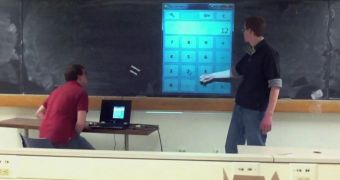Touchscreens have become quite popular, but they aren't easy or cheap to make, not to mention that there are a lot of scenarios where they are absent, or not large enough.
The video above, by Seth Pollen and Nathan Radtke, shows how their single-sensor acoustic localization technology works.
First off, an accelerometer is stuck to a blackboard, or any surface really.
Secondly, a custom piece of software is launched after a projection is cast upon the surface.
After that, through sets of three taps, the software is calibrated to detect exactly which interactive areas are supposed to respond to touch input. That means that the rest of the blackboard can be used normally, or for different projections.
The video used the Windows calculator in the demonstration. The overall goal is to make touch input cheaper, portable, possible to enable on any surface and, of course, more widespread.

 14 DAY TRIAL //
14 DAY TRIAL //